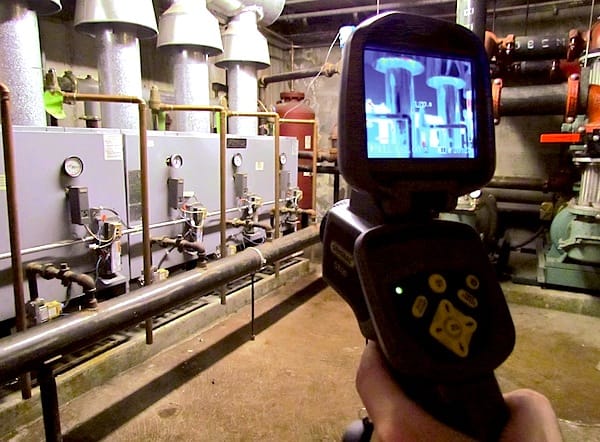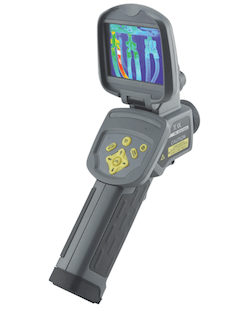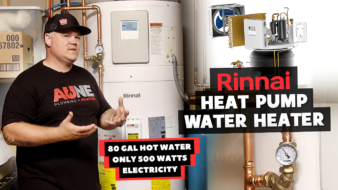In the past, when conducting contractor tool surveys, I’ve seen many different answers to the question, what is your favorite tool? The answers vary, really, from pipe wrench, phone, ruler, brain, calculator, sawzall, jetter and, yes, fellow contractors on the job.
But a tool that is a must for every contractor’s truck is a thermal imaging camera. Sure, some of the high-end devices can get a bit pricey, but these cameras are a strategic investment and typically pay for themselves in a short period of time.
 Thermal imaging cameras—IR cameras—are state-of-the-art instruments that can quickly, easily and accurately detect and measure thermal conditions and temperature differences from a distance by converting an object’s invisible infrared radiation to a visible color image. “By doing so, they can provide a detailed ‘thermal map’ of any building, room, system or piece of equipment, which supports installation and maintenance troubleshooting and repairs,” says Karen Kwong, product development engineer, General Tools & Instruments (General®).
Thermal imaging cameras—IR cameras—are state-of-the-art instruments that can quickly, easily and accurately detect and measure thermal conditions and temperature differences from a distance by converting an object’s invisible infrared radiation to a visible color image. “By doing so, they can provide a detailed ‘thermal map’ of any building, room, system or piece of equipment, which supports installation and maintenance troubleshooting and repairs,” says Karen Kwong, product development engineer, General Tools & Instruments (General®).
An essential investment, thermal imaging cameras (TICs) can save time and money—not to mention generate significant long-term savings—by helping contractors assess the thermal conditions of HVAC and plumbing systems, equipment and components, as well as electrical and structural building components.
“It’s in the truck everyday. It has saved us countless square feet of sheetrock repairs, being able to pinpoint moisture prior to hacking away at the walls. Works exceptionally well at diagnosing improper flow conditions in hydronic systems, as well. It’s actually pretty sweet to be able to see what is happening inside the pipe, and I have seen first hand and in real time proper hydraulic separation,” says Andy Mickelson, Mickelson Plumbing & Heating, Missoula, Mont.
By creating a visual image of temperature differentials, infrared cameras enable contractors and technicians to see hidden problems in ductwork, pipes and tubing, and equipment and machinery. For example, temperature differentials can signal water leaks, areas of water intrusion, and blockages in both water lines and HVAC ductwork. Temperature spikes and differentials can also signal problems with energy efficiency, easily locating areas of heating or cooling loss, which is ideal for energy audits. Rising temperatures and rapid or excessive heat buildup often signal malfunctions and abnormal or fault conditions in equipment and machinery. These include problems brought on by wear, imbalance, misalignments, insufficient cleaning or lubrication, friction and electrical issues in rotating machinery—such as motors, turbines and compressors, and their bearings, couplings and gearboxes.
“Armed with an infrared camera, a contractor can safely and accurately evaluate conditions from a distance, which is particularly useful when equipment and components are difficult to reach, inaccessible or hazardous. The visual thermal images (or thermograms) that the camera generates—with multiple temperature points—enable the diagnosis of equipment malfunctions and poor performance far more effectively than more conventional, single-spot temperature measurement devices,” says Kwong.
It would take hours for a contractor to take individual measurements with an IR thermometer and plot them on a drawing. Plus, they would not be simultaneous readings. The ability to gather and analyze temperature data in real time (and over time) helps pinpoint existing issues and identify the onset of emergent problems, continues Kwong.
“It is useful for finding flow problems (air or water) in high-ceiling areas such as airports, for finding building enclosure deficiencies and the like,” says Bradford White, associate and TMP Consulting Engineers Inc., Boston.
IR Camera Benefits
Kwong breaks down the benefits of the investment:
• TICs allow for the quick detection of potential problems or defects, which reduces troubleshooting time and preventative maintenance.
• Using thermal imaging technology on a routine basis helps to develop a more strategic and proactive approach to maintenance. For example, thermal images of a given piece of equipment or a specific equipment component can be captured at preset intervals and compiled over time. Such records can provide timely indications of deteriorating conditions—and even help to make reasonable predictions about future deterioration—so the appropriate maintenance and repair can be done at the most appropriate time, in the most cost-effective manner.

Point and click. Thermal imaging cameras can find concealed leaks and blockages in water and sewer lines, including in piping and tubing behind walls, below floors and above ceilings.
• In commercial or industrial settings, the use of IR thermography to inspect, troubleshoot and diagnose problems in real time—that is, while machinery is running, without interrupting processes—will help improve the efficiency and effectiveness of component-specific and facility-wide operations and maintenance, providing opportunities for a quick ROI as well as long-term savings. For example, better preventive and predictive maintenance means reduced risks of expensive or catastrophic equipment failures and, consequently, of unplanned downtime or shutdown, which can translate into lost production.
Thermal imaging cameras are best for such applications as:
• Locating hot and cold water lines
• Finding concealed leaks and blockages in water and sewer lines, including in piping and tubing behind walls, below floors and above ceilings
• Locating hidden blockages in HVAC ducts, bathroom exhaust vents and dryer vents as well as uninstalled, misrouted or disconnected HVAC duct lines
• Locating invisible or inaccessible thermal leaks and pinpoint leak sources (e.g., in piping or ductwork)
• Diagnosing heat exchanger, motor or compressor maintenance issues
• Inspecting integrity of thermal insulation
• Revealing overheated electrical circuits
• Checking/monitoring combustion or temperature-controlled processes
• Assessing the “thermal envelope” of buildings and detecting specific areas of energy loss
• Supporting maintenance and repair efforts by documenting problem areas.
The Future of Thermal Imaging
Higher resolution will allow better remote and long-distance diagnostic and monitoring work. “I also think there will be more integrated solutions. Picture-in-picture will become a standard feature, and we will see more video and thermal integrated features, or even integration with radar. And there will be more wireless applications,” says Kwong.
 Finally, Kwong contends that thermal imaging cameras will also be equipped to fight even harsher environmental conditions. In addition to hardware improvements, we will also see more sophisticated software development, training and services as a result of manufacturers trying to differentiate themselves from the competition. The products therefore will become more and more accessible and affordable for average consumers.
Finally, Kwong contends that thermal imaging cameras will also be equipped to fight even harsher environmental conditions. In addition to hardware improvements, we will also see more sophisticated software development, training and services as a result of manufacturers trying to differentiate themselves from the competition. The products therefore will become more and more accessible and affordable for average consumers.
General Tools & Instruments
General Tools & Instruments (General) offers a full line of TICs, 13 models in total. General’s “PREDATOR” Thermal Imaging Camera line spans from a basic model to mid-range models with in-camera analysis features to highly-sophisticated models with advanced analytics and reporting software. Some other variable features include pixel resolution*, picture-in-picture (i.e., thermal and visual image fusion), number of moveable spots (i.e., simultaneous temperature analysis of two changeable pinpoints) data and image recording/storage, streaming video and voice annotation. Extended temperature measurement range models are also available (up to 600°C (1112°F), 1000°C (1832°F) and 1500°C (2732°F).
 The cameras’ manual focus, optional interchangeable lenses and high resolution provide more accurate images and assessments than competitive models. They generate powerful, convincing thermograms and related data that help technicians and contractors document findings, design solutions and convince customers or managers to authorize recommended repairs. Temperature data is displayed numerically and as an infrared colorized thermal image. The contractor can assign a range of colors to signify specific temperature ranges.
The cameras’ manual focus, optional interchangeable lenses and high resolution provide more accurate images and assessments than competitive models. They generate powerful, convincing thermograms and related data that help technicians and contractors document findings, design solutions and convince customers or managers to authorize recommended repairs. Temperature data is displayed numerically and as an infrared colorized thermal image. The contractor can assign a range of colors to signify specific temperature ranges.
* The highest resolution currently offered by General is 384 x 288 pixel resolution (for thermal images) 640 x 480 pixel resolution (for picture-in-picture/fusion images).
As is typical of sophisticated test and measurement instruments, the more “bells and whistles” a model provides, the more it costs. General’s base model retails around $2,000 and its top-tier model around $5,500.
General’s TICs can provide powerful, convincing images and data the cameras generate serve to document contractors’ findings, aid in designing solutions and help to convince customers or managers to authorize recommended repairs.





Join the conversation: